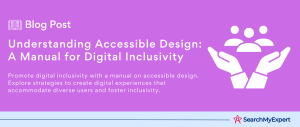Digital Design in Social Media Communication
Embracing Visuals in the Age of Social Media
In today’s fast-paced digital world, social media has become a cornerstone of communication. It’s not just about words; it’s about capturing attention, engaging minds, and conveying messages through compelling visual content. This is where digital design plays a pivotal role.
The Power of Digital Design
Digital design is the heartbeat of social media communication. It’s the art and science of creating visual content that is not only eye-catching but also meaningful and message-driven. Why is it so crucial?
- Attention-Grabbing:
We live in an era of information overload. Visuals cut through the noise, making your message stand out. - Emotional Connection: Good design evokes emotions. It can make your audience feel, react, and remember.
- Brand Identity:
Consistent, well-crafted design is key to building a strong, recognizable brand presence on social media. - Message Clarity: In a world where time is precious, visual content delivers messages quickly and effectively.
Engaging Users in a Scroll-Stopper Culture
Social media users are notorious for scrolling. To make them pause, you need more than just text. You need visuals that pop, tell a story, and create a moment of engagement. This is where digital design comes into play, transforming standard posts into scroll-stoppers.
Visual Content: More Than Just Aesthetics
It’s not just about looking good. Visual content on social media has to be:
- Relevant:
Matching the interests and needs of your target audience. - Valuable:
Providing information, entertainment, or inspiration. - Shareable:
Encouraging users to spread the word.
Understanding Your Audience in Digital Design
Tailoring Design for Target Audience on Social Media Platforms
In the realm of social media, one size does not fit all. Your digital design strategy must be as diverse and dynamic as your audience. Understanding your audience is not just beneficial; it’s crucial for effective communication and engagement.
Knowing Your Audience: The Key to Effective Design
Before you start designing, ask yourself: Who are you trying to reach? Each audience segment has unique characteristics, preferences, and behaviors. Here’s what to consider:
- Demographics: Age, gender, location, and occupation can significantly influence design preferences.
- Interests and Habits:
What do they like? What social media platforms do they frequent? - Psychographics:
Understanding their values, attitudes, and lifestyle helps in creating resonant content.
Design for the Platform
Each social media platform has its own culture and preferred content formats:
- Instagram:
High-quality visuals, short and snappy text. - Facebook:
A mix of images, videos, and longer text. - Twitter: Quick, engaging visuals paired with brief text.
- LinkedIn: Professional, informative visuals with a more formal tone.
Adapting Visuals to Audience Preferences
Once you understand your audience, tailor your visuals accordingly. Younger audiences might prefer bold, bright colors and dynamic designs, while a more mature audience might appreciate subtler, cleaner aesthetics.
Consistency Meets Customization
While it’s important to customize your design for each audience segment, maintaining a consistent brand identity across all platforms is equally important. This balance ensures brand recognizability while still catering to different preferences.
Defining Your Brand Identity in Digital Design
Crafting a Consistent Brand Image on Social Media
In the digital landscape, your brand identity is more than a logo or a tagline; it’s the visual language that tells your story. Consistency in this visual language across all platforms is key to building brand recognition and trust.
The Elements of Brand Identity
Your brand identity is a combination of various elements, each playing a critical role:
- Colors:
They evoke emotions and associations. Choose a palette that reflects your brand’s personality. - Fonts:
Typography speaks volumes. Select fonts that align with your brand’s tone and values. - Design Elements:
This includes logos, icons, and other graphics that become synonymous with your brand.
The Power of Recognition and Trust
Consistency in these elements across all social media platforms helps in:
- Building Recognition:
When your audience sees a consistent visual style, they instantly recognize it as your brand. - Establishing Trust: Consistency signals professionalism and reliability, fostering trust among your audience.
Creating a Social Media Style Guide
A style guide is your brand’s rulebook. It ensures that everyone representing your brand is on the same page. Your style guide should include:
- Visual Guidelines: Detailed specifications of your color palette, typography, logo usage, and other design elements.
- Tone of Voice: How your brand communicates, including the language and personality conveyed in your content.
- Best Practices for Each Platform:
Tailoring your brand identity to fit the unique style of each social media platform while maintaining overall consistency.
Choosing the Right Design Tools for Social Media
Navigating the Landscape of Digital Design Software
In the world of digital design, the tools you choose can make a significant difference. From intuitive, beginner-friendly platforms to sophisticated, professional-grade software, there’s a tool for every skill level and need.
Beginner-Friendly Platforms: Canva and Beyond
Canva: A user-friendly tool perfect for beginners or those seeking quick, quality designs. Features include:
- Pre-designed templates.
- Drag-and-drop interface.
- Library of images, icons, and fonts.
Other Options: Tools like PicMonkey and Snappa also offer easy-to-use interfaces with similar features.
Professional Software: Adobe Suite and Others
Adobe Photoshop: The gold standard for professional designers. Key features include:
- Advanced photo editing and manipulation.
- Layer-based editing.
- Extensive toolset for complex designs.
Adobe Illustrator: Ideal for vector-based designs. Offers:
- Precision drawing tools.
- Scalable vector graphics.
- Comprehensive typography tools.
Other Professional Tools: Software like CorelDRAW and Sketch also provide advanced features for seasoned designers.
Choosing the Right Tool for You
- Skill Level:
Are you a beginner, intermediate, or advanced user? - Project Needs: Consider the complexity and type of designs you aim to create.
- Budget:
Free tools are great for starters, while professional tools are an investment in advanced capabilities.
Design Principles for Social Media Visuals
Mastering the Art of Social Media Design
Creating captivating visuals for social media involves more than just choosing the right images and colors. It requires an understanding of core design principles that can make your content stand out.
Core Design Principles Explained
- Composition:
This is about arranging elements harmoniously. Use grids and alignment tools to create balanced, visually appealing images. - Hierarchy:
Prioritize your message by using size, color, and placement to guide the viewer’s eye to the most important information first. - Color Theory:
Colors can set a mood, convey a message, and create impact. Use complementary colors for harmony and contrasting colors for emphasis. - Negative Space: Also known as ‘white space’, this isn’t just empty space. It’s a powerful tool to make your content more readable and to focus attention on key elements.
Practical Tips for Applying These Principles
- Balanced Composition:
Use the rule of thirds to place key elements. This divides your design into nine equal parts, ensuring a more dynamic and engaging layout. - Effective Hierarchy:
Make your main message the largest element, and support it with smaller, secondary information. - Strategic Color Usage:
Choose a palette that reflects your brand identity. Use bold colors to highlight, and muted tones for backgrounds. - Leveraging Negative Space: Don’t overcrowd your design. Use negative space to give your content breathing room, enhancing overall clarity.
Content Formats and Trends in Social Media
Navigating the Diverse World of Social Media Content
Social media is a dynamic and ever-evolving platform, and staying abreast of the latest content formats and design trends is key to keeping your audience engaged.
Popular Social Media Content Formats
- Static Images: Timeless and straightforward. Ideal for conveying clear, concise messages.
- Infographics:
Perfect for data-driven storytelling. They make complex information easily digestible. - Videos:
Highly engaging, videos can tell a story or showcase a product in action. - Stories:
Ephemeral content that’s great for real-time engagement. - Live Streams: Foster a sense of immediacy and authenticity, connecting with the audience in real-time.
Current Design Trends and Best Practices
- Static Images: Focus on high-quality imagery with bold, attention-grabbing elements. Minimalism is key.
- Infographics: Use clear, easy-to-read layouts. Incorporate charts and icons for visual interest.
- Videos: Short, engaging clips work best. Include captions for accessibility.
- Stories:
Be creative and interactive. Use stickers, polls, and questions to engage viewers. - Live Streams:
Ensure good lighting and clear audio. Engage with your audience by answering questions and acknowledging comments.
Measuring and Refining Your Social Media Strategy
Leveraging Analytics for Enhanced Digital Design
In the realm of social media, understanding how your audience interacts with your content is pivotal. By tracking key metrics, you can refine your strategy for better engagement and overall performance.
The Importance of Tracking Key Metrics
- Engagement:
Measures likes, comments, shares, and overall interaction with your content. - Reach:
Indicates how many unique users have seen your post. - Click-Through Rates (CTR):
Shows how often people click on the links in your posts.
Data-Driven Decision-Making
- Analyze Your Performance:
Use analytics tools to track these metrics. Understand what works and what doesn’t. - Refine Your Design Approach:
If certain types of visuals are getting more engagement, it’s a sign to produce more of that content. - Test and Iterate:
Experiment with different designs, times for posting, and types of content. Use metrics to gauge success. - Optimize for Your Audience: Tailor your content based on audience preferences as revealed by the data.
Continuous Improvement for Optimal Performance
Remember, social media is dynamic. What works today may not work tomorrow. Stay adaptable and ready to refine your strategy based on the data at hand.
Conclusion
Tracking and understanding key social media metrics is crucial for a data-driven and effective design approach. By continually measuring, analyzing, and refining your strategy, you can ensure that your social media presence is not just vibrant but also strategically optimized for success.
Craft cutting-edge digital solutions with expert Digital Design Firms.
Table of Contents
Toggle






